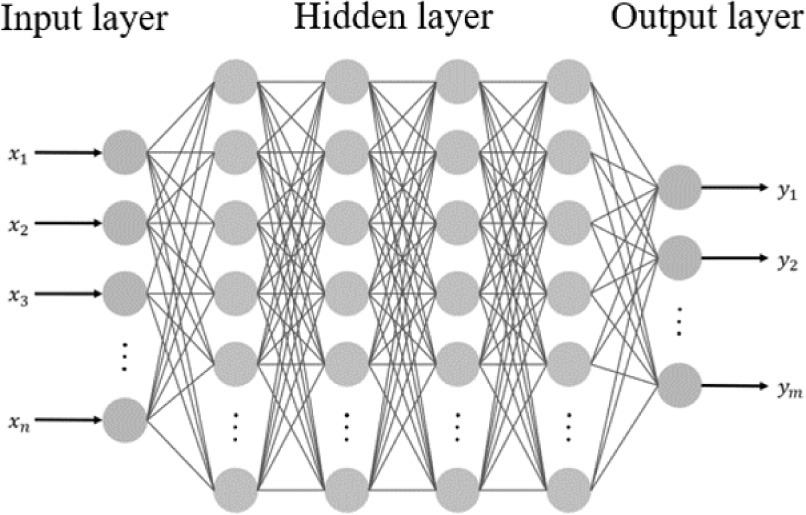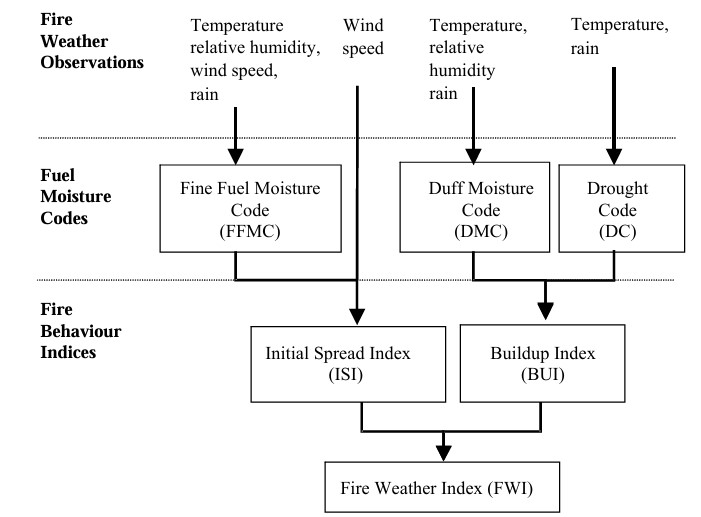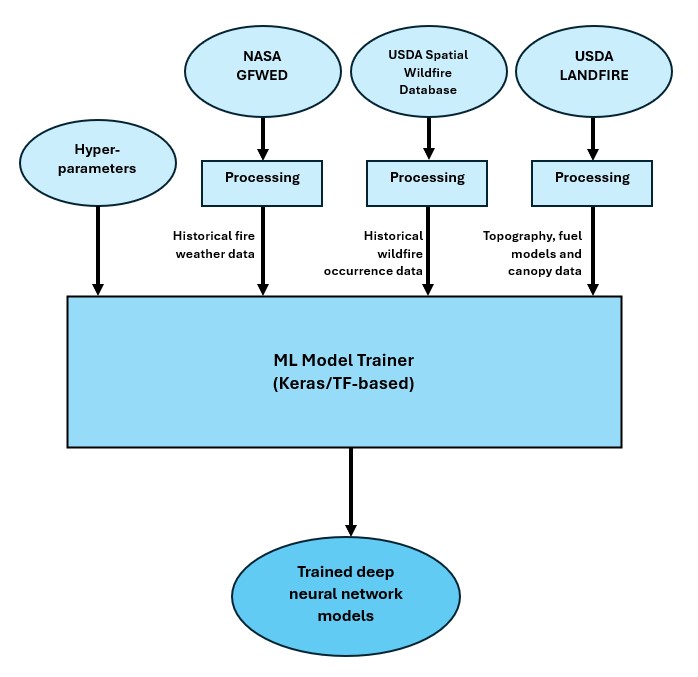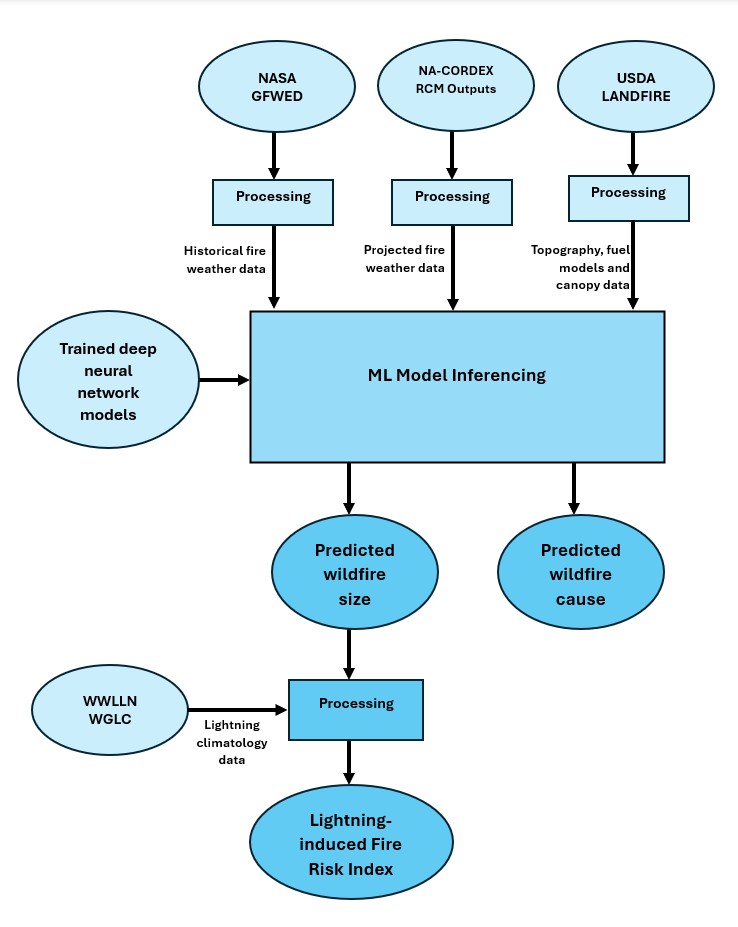What is FireVision?
FireVision is a deep-learning model for predicting wildfire characteristics in the western United States at both weather and climate timescales. FireVision is available as an easy-to-use web app. The model has been trained on historical fire data between 1992 and 2020, as well as detailed landscape and fire weather data for fire locations. One of the unique features of FireVision is that it can look into the future and predict wildfire characteristics up until 2040 as the climate changes.
Given a potential ignition location and time frame for a wildfire, the model will predict the likely final size class of the fire, representing the susceptibility of the location to wildfires: under 100 acres, over 100 acres but under 1000 acres, or over 1000 acres. The time frame is month and year for long-term projections through 2040, and month and day for short-term wildfire forecasts for the next two weeks. The model will also predict the likely cause of the fire at that location for the time of year: natural or human. Probabilities of fire sizes and causes are provided in the outputs.
In addition, FireVision also outputs the new Lightning-induced Fire Risk Index (LFRI), combining wildfire susceptibility (as measured by the potential fire size) and lightning climatology for that location and time of year.
FireVision targets the eleven contiguous western states in the United States: Washington, Oregon, California, Idaho, Nevada, Arizona, Montana, Utah, Colorado, Wyoming, and New Mexico.
This version of FireVision is a free community service from Model Paths.
How to Use FireVision
- Predict fire characteristics at a specific ignition location: Go to the main page by clicking FireVision at the top. Enter an address (full street address, or just a city and/or state and/or zip code); or click on a location in the map; or directly enter a latitude/longitude -- all within the eleven contiguous western states in the US. Select a fire weather year (historical or projected) and month. Then press Predict Wildfire Characteristics. The results are then displayed on the right, and the ignition location on the map is highlighted with a heatmap symbol proportional to the predicted fire size.
-
View long-term firecasting maps on a climate timescale: Select either susceptibility or risk maps under Firecasting Maps - Longer Term at the top. Time frame is between now and 2040.
- The susceptibility maps pagepage displays projected (conditional) fire sizes for ignition locations across all eleven states at a 20kmx20km resolution. Select a fire weather year (historical baseline or projected) and month to see the distribution of conditional fire sizes for the month. Change the month to see how the distribution changes across a year and change the year to see how the monthly distribution changes over time.
- The risk maps page displays the Lightning-induced Fire Risk Index (LFRI) for locations across all eleven states at a 20kmx20km resolution. Select a fire weather year (historical or projected) and month to see the distribution of risk index for the month. Change the month to see how the distribution changes across a year and change the year to see how the monthly distribution changes over time.
-
View short-term firecasting maps on a weather timescale: Select either susceptibility or risk maps under Firecasting Maps - Short Term at the top. Time frame is the next two weeks.
- The susceptibility maps page displays forecasted (conditional) fire sizes for ignition locations across all eleven states at a 20kmx20km resolution. Select a specific date (historical baseline or forecasted) to see the distribution of conditional fire sizes for that date and compare the forecasted fire sizes to the baseline.
- The risk maps page displays the Lightning-induced Fire Risk Index (LFRI) for locations across all eleven states at a 20kmx20km resolution. Select a specific date (historical baseline or forecasted) to see the distribution of risk index for that date and compare the forecasted risk index to the baseline.
-
View other wildfire maps: Select either wildfire cause or historical wildfire maps under Other Wildfire Maps.
- The cause maps page displays predicted causes of fires (natural or human-caused) for ignition locations across all eleven states at a 10kmx10km resolution. Select a month to see the distribution of fire causes for the month.
- The historical maps page displays the actual wildfire sizes and causes for all recorded wildfires in the 11 western states in the US between 1992 and 2020.
How to Interpret the Results
There are three parts to the wildfire predictions from FireVision’s deep-learning ML models:
- Potential wildfire size: This is a measure of fire susceptibility at any ignition location. It is conditional on an ignition occurring at that location and predicts the potential final size of the fire. The output is one of three fire size classes: under 100 acres (small), over 100 acres but under 1000 acres (medium), or over 1000 acres (large). Potential fire sizes will be larger if the combination of vegetation, topography and fire weather are conducive to larger fires.
- Potential wildfire cause: The cause of a fire can be human or natural. While the majority of wildfires are human caused, natural causes (basically lightning) account for the larger part of acres burnt. For any given ignition location, the models will predict the cause of the fire, considering factors such as the time of year (lightning is more active in summer months), elevation and distance to urban areas. For the same location, the likely wildfire cause will change across the months of a year. This is also conditional on an ignition occurring at the location.
- Lightning-induced Fire Risk Index (LFRI): This is a new risk index that combines the potential wildfire size (which is conditional on an ignition occurring) and the chances of an ignition from lightning. We compute this index as follows: LFRI = Fire_size * Lightning_power_density/24. Fire_size is chosen to be approximately in the middle of the range for each of the three size classes (i.e., 50, 500 or 5000 acres) and indicates susceptibility to wildfires. Lightning_power_density is the average power density per day from lightning strokes at a given location (measured in MW/km2/day) for a given month and indirectly captures the probability of ignition. This index only covers wildfires from natural causes which account for most of the large wildfires and the bulk of the total acres burnt each year. There is no upper limit for LFRI, but values are generally in the 0-1 range. A higher LFRI indicates an elevated risk for wildfires (including the chances of ignition) at a given location for a particular month and year. There is no similar index for human-caused fires because of the difficulty of estimating the ignition probability, and also because the ignition probability is under human control and can be reduced proactively through education, regulation, and preventive maintenance.
Applications
FireVision can be used in applications ranging from wildfire prevention and mitigation to insuring and derisking catastrophic events.
- Wildfire prevention: Given the vast number of potential ignition locations from power lines and human activities, there is a clear need for prioritizing these locations and narrowing down to a manageable set of locations that can be targeted with efforts to reduce the probability of ignition. Fire susceptibility evaluations can be undertaken with FireVision to identify critical locations (from a list of locations) that are most susceptible to wildfires due to topography, surface-level fuels, canopies, and/or dryness. These locations could include certain wildland areas through which high-voltage power lines run, as well as specific camp sites and other wildland-urban interface areas that are primed to burn and where human activity can ignite fires inadvertently. Once these critical locations have been identified, preventive actions could range from education and rigorous enforcement of rules to maintenance of power-line equipment and clearing of vegetation near particular stretches of power lines.
- Wildfire mitigation: Fire susceptibility predictions from FireVision can be used to prioritize locations for mitigation steps that can help reduce the spread of fires. Mitigation actions might include prescribed burns, removal of forest debris and mechanical thinning in locations that have the capacity to turn an ignition of any kind (including from a spreading wildfire) into a large fire.
- Carbon credits: Nature-based carbon credits depend on carbon being sequestered in swaths of natural and planted forests for many decades. Forest fires can destroy this assumption and release large amounts of carbon back into the atmosphere before their time. Susceptibility and risk measures generated by FireVision can be used to evaluate the permanence of specific forestry-based carbon offset projects so buyers can make informed decisions. Carbon registries can also require larger buffer pools for projects located in higher risk/susceptibility areas.
- Insurance/reinsurance: With the increasing frequency, size and the ultimate cost of wildfires, the insurance industry needs better tools for evaluating wildfire risk and susceptibility. This is needed not only for setting insurance premium rates, but for managing the overall risk and having the capital to draw on in case of catastrophic events. One way that the insurance industry reduces risk from events like wildfires is by using catastrophic bonds, which in turn require risk assessments. FireVision is uniquely positioned to serve this need.
Methodology
Deep Learning Models
FireVision includes three machine learning models built using deep neural networks (DNNs), two for fire size classification and one for fire cause classification. We use DNNs here in order to capture interesting and useful relationships and interactions between variables in a highly nonlinear and complex system. Our current models are densely connected networks of 6-12 layers, each with 700-2048 neurons. The models deployed in this web app are a result of an extensive training and hyper-parameter tuning phase. We use up to a few million data points for training and testing, generated by our proprietary data synthesis algorithm which builds on and expands the available historical fire data. Accuracy on test data not seen before is generally 85-95%.

Fire Weather Index
The Fire Weather Index (FWI) system is used widely to forecast the effect of weather on fire behavior. Our ML models have been trained with the FWI data (including its components shown in the diagram below) on the day and location of each historical fire. The Fuel Moisture Codes represent three classes of forest fuel, each with different drying rates, nominal fuel depth and nominal fuel loads. The Fine Fuel Moisture Code (FFMC) represents the moisture content of fine fuels and litter on the forest floor. The Duff Moisture Code (DMC) represents the moisture content of loosely compacted decomposing organic matter. The Drought Code (DC) represents the moisture content of deep compact organic matter of moderate depth.

Model Training
The ML models in FireVision have been trained using the historical record of all wildfires between 1992 and 2020 in the US west. The training also utilizes landscape data corresponding to each of the fires (including topography, surface-level fuel models and canopy structures) as well as historical fire weather data for the specific location and date of each fire.

Model Inference
Model inference uses landscape data and historical fire weather data, as well as projected fire weather data through 2040 calculated from the dynamically downscaled regional climate model outputs in the NA-CORDEX archive run using boundary conditions from CMIP5 global climate model simulations. In addition, lightning climatology data is used to calculate the Lightning-induced Fire Risk Index.

Model Validation
Given the blackbox nature of ML models, the ability to interpret and validate the model predictions is becoming increasingly important. Our rigorous methodology includes a multipronged approach to accomplish this.

- Model inference on data not used in training: Our methodology sets aside a certain percentage of the input data for validation and testing. This holdout dataset is used after the training process for final validation and testing of the models.
- Local sensitivity analysis on selected geo locations based on the classic OAT method provide insights on what the models have learned from the training data and which input attributes are most influential under different conditions.
- Global sensitivity analysis using the Sobol sensitivity indices to capture the interactions between parameters in highly nonlinear models.
- Model inference across the entire gridded space (i.e., across all eleven states, currently at a 20km x 20km resolution) and displayed on maps for manual sanity checks against known fire patterns. This is available to users on the Risk Maps, Susceptibility Maps, and Cause Maps pages. The Historical Maps page shows the distribution of fire sizes and causes for all recorded fires between 1992 and 2020, and serves as a reference to compare with.
- Model inference in an adjacent state: As an additional validation step, we also ran model inference on all historical fires (1992-2020) in Texas, which were not part of the training data for the ML models.
Data Sources
- USDA Forest Service: LANDFIRE Data Products
- Short, K.C. Spatial wildfire occurrence data for the United States, 1992-2020 (2022)
- NASA: Global Fire WEather Database (GFWED)
- Mearns, L.O., et al. The NA-CORDEX dataset. NCAR Climate Data Gateway, Boulder CO (2017)
- The WWLLN Global Lightning Climatology and timeseries (WGLC), 2024 Data Release
References
- Scott, J.H., et al. Standard Fire Behavior Fuel Models: A Comprehensive Set for Use with Rothermel’s Surface Fire Spread Model (2005)
- Finney, M.A., et al. A simulation of probabilistic wildfire risk components for the continental United States (2011)
- McGinnis, S., et al. Building a climate service for North America based on the NA-CORDEX data archive. Climate Services, vol. 22 (2021)
- Christensen, O.B., et al. CORDEX Archive Design (2020)
- Dowdy, A.J., et al. Australian fire weather as represented by the McArthur Forest Fire Danger Index and the Canadian Forest Fire Weather Index. CAWCR Technical Report No. 10 (2009)
- Field, R.D., et al. Development of a Global Fire Weather Database. Nat. Hazards Earth Syst. Sci., 15 (2015)
- Kaplan, J.O., et al. World Wide Lightning Location Network (WWLLN) Global Lightning Climatology (WGLC) and time series (2022)
- Tunkiel, A.T., et al. Data-driven sensitivity analysis of complex machine learning models (2020)
- Tosin, M., et al. A Tutorial on Sobol’ Global Sensitivity Analysis Applied to Biological Models (2020)
Release Notes
- V2.1 (July 2024): Weekly short-term firecasting. Starting weekly firecasting (forecasts of wildfire susceptibility and risk) for the following two weeks across the 11 western US states, providing gridded maps and single-location wildfire analysis. Updated firecasts will be released each Monday.
- V2.0 (May 2024): First production release. Added lightning power density as an additional variable for evaluating wildfire risk from natural causes, resulting in the new Lightning-induced Fire Risk Index (LFRI). Significantly expanded and speeded up the various maps.
- V1.3 (April 2024): Model predictions expanded to future years until 2040 using fire weather index components calculated from CMIP5 climate simulations dynamically downscaled to North America and bias corrected.
- V1.2 (March 2024): Added weather as a key variable (through the Fire Weather Index). The retrained ML models can now be queried using the month of the year and the location in the form of an address or latitude/longitude. Under the hood, FireVision uses the location-specific average monthly weather for 2021-2023. Fire size maps are available for May-November showing the changes and progression in fire risk through the fire season across the western US on a 20km grid.
- V1.1 (February 2024): Expanded coverage to the eleven contiguous western states in the US. Updated and retrained all the ML models. Added map views of fire sizes and causes across all eleven states.
- V1.0 (January 2024): Initial release covering three west-coast states.
Questions and Feedback
If you have general questions about FireVision, specific questions about results produced by FireVision, or any feedback/suggestions, please drop us a note by email and we'll get back to you promptly.